Each baseball field requires a meticulously planned lighting design, regardless of whether it is a stadium, high school, or college facility. Achieving the appropriate light level is crucial, and standard LED flood light optics might not always suffice. Nowadays, sports venues utilize LED lighting systems that meet the specifications set by relevant associations.
To ensure compliance with lighting requirements for a high school baseball field, it’s essential to understand the specific standards for high school facilities. In the following sections, we will explore how to meet these lighting requirements in a high school stadium. Finally, our baseball field lighting buyer’s guide will provide valuable insights on what to look for to secure a great deal.
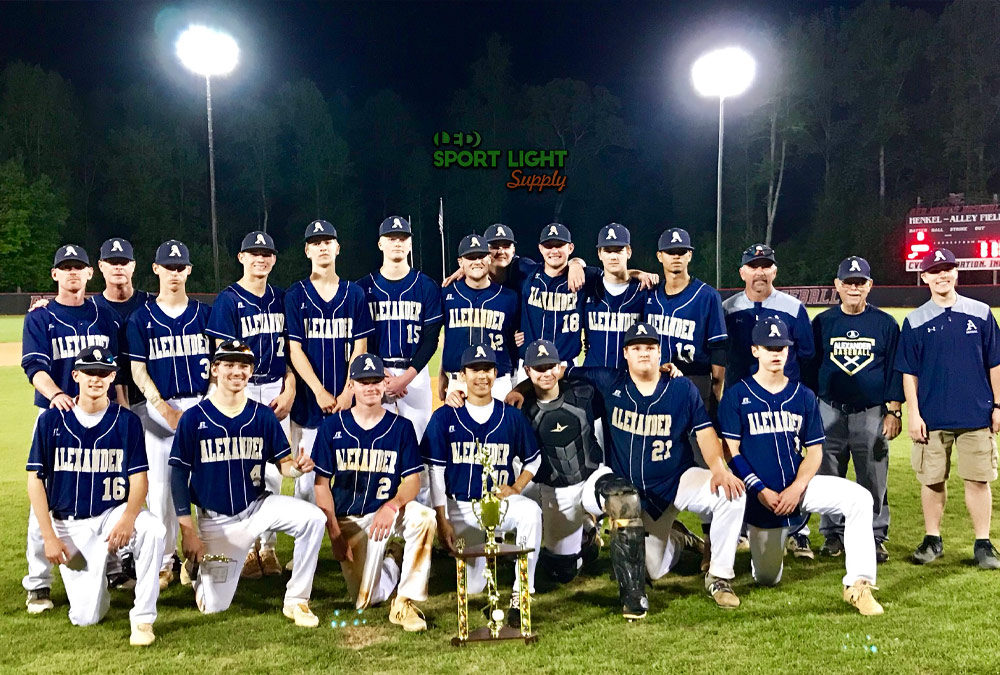
Table of Contents
ToggleWhat Are the High School and College Baseball Field Lighting Standards?
High School Baseball Field Lighting Standards
The lighting standards for baseball and softball fields are essentially the same. Both sports require carefully planned lighting to ensure high-quality illumination. Proper lighting design is crucial for both baseball and softball fields to provide optimal playability.
To establish standardized brightness, there are two key factors to consider: the placement of light poles and the specifications of each lamp. Understanding these elements is essential for meeting lighting standards. Let’s explore each aspect of the baseball field lighting standards in detail.
High School Baseball Field Light Pole Standards
Light Pole Location (Lighting Layout)
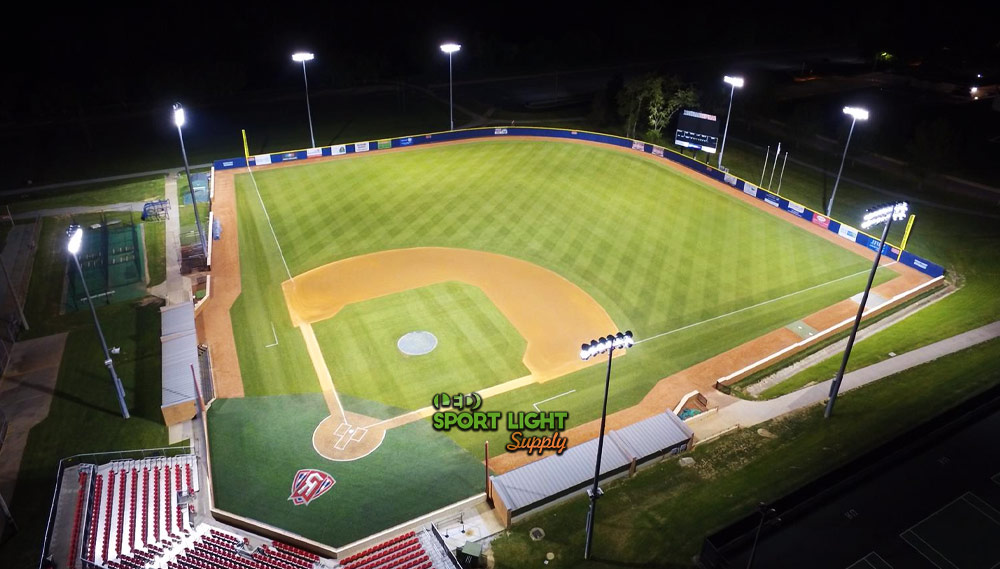
The positioning of light poles is crucial for ensuring adequate playability. There are three commonly used lighting layouts to achieve sufficient illumination.
For smaller fields with a radius under 250 feet, a four-pole layout is typically used. In this configuration, two poles are positioned on either side of home plate, while the remaining two are placed near first and third base.
For fields with a radius greater than 250 feet, a six-pole layout is more appropriate. This design includes two high mast poles dedicated to illuminating the outfield.
In larger stadiums with a radius of 320 feet or more, an eight-pole layout is employed. This setup adds two additional high mast poles to enhance outfield illumination.
The correct placement of light poles is vital to ensure that the entire field is evenly illuminated and safe for players. Improper positioning can lead to insufficient lighting, impacting the playability of the field.
Number of Poles
The number of poles required depends on the size of the field. Smaller fields typically use a four-pole design, while larger fields might require six or eight poles to ensure comprehensive and even lighting coverage.
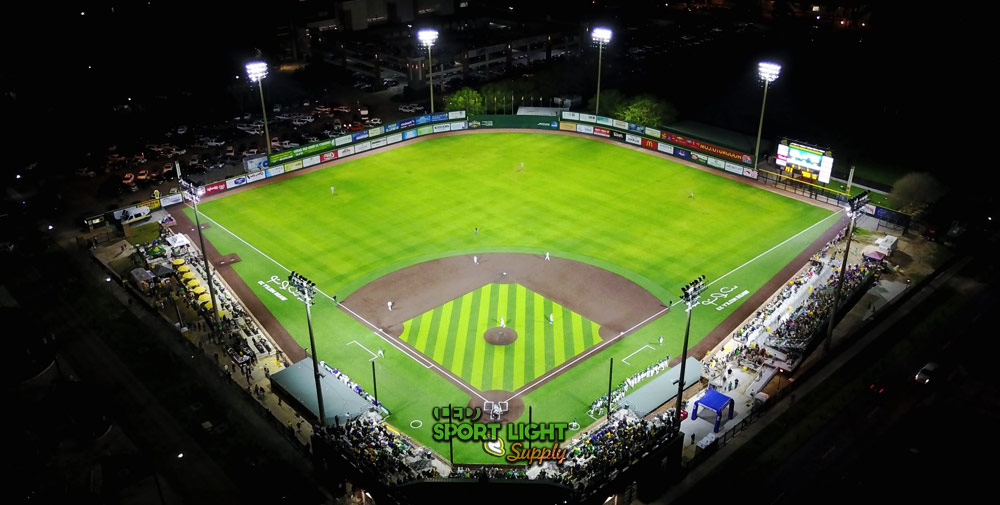
Pole Height
The height of the poles is important because the flood lights need to be installed at specific angles to achieve the desired illumination. The vertical angle at which the lights are aimed affects both the quality and quantity of light and helps reduce issues such as glare and light pollution.
For infield illumination, LED fixtures should be aimed at a vertical angle of 25 degrees. For outfield illumination, a vertical angle of 21 degrees is generally sufficient. Proper aiming of the fixtures ensures even lighting distribution and minimizes unwanted light spill.
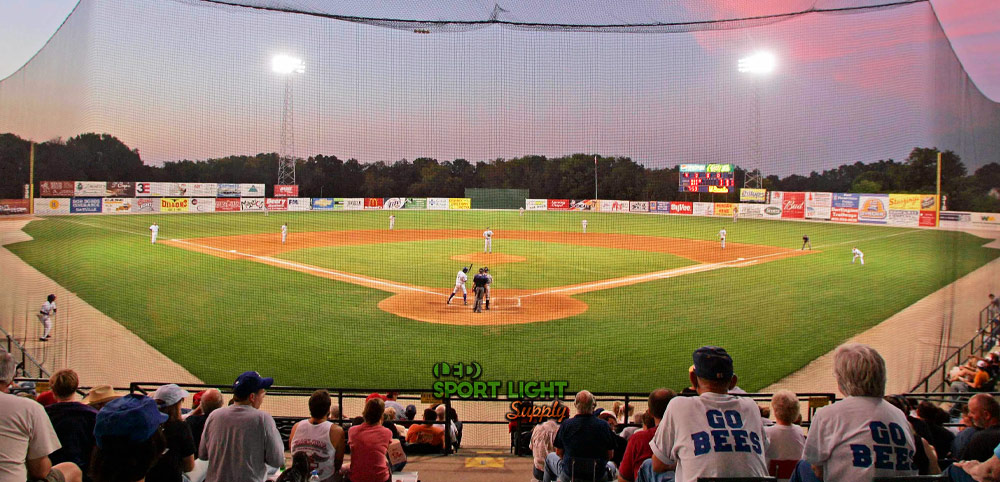
Pole Material
The durability of the light poles is crucial for long-term use. Poles must be constructed from high-quality materials to withstand various weather conditions and extensive use. Galvanized steel is a commonly chosen material due to its strength and resistance to environmental factors.
A licensed engineer should verify the strength and stability of the pole foundation, and manufacturers should provide warranties to ensure the poles’ reliability over time.
Lightning Protection
A lightning protection system is essential to safeguard flood lights from lightning strikes. Compliance with NFPA 780 standards requires the installation of lightning rods or dissipation arrays on top of each high mast. Additional grounding electrodes and secondary conductors may be needed to effectively disperse lightning energy.
Lighting Control Systems (DMX/DALI)
Lighting control systems such as DMX and DALI are employed to manage flood lights efficiently. The DMX protocol uses XLR connectors, either 3-pin or 5-pin, to control up to 512 or 1024 channels, respectively. This system allows precise adjustments of brightness, color temperature, and other features.
The DALI system, on the other hand, manages the entire lighting setup by assigning addresses to each luminaire. This system enables grouping and isolating fixtures, allowing for adjustments in light intensity for individual or groups of lights.
Both DMX and DALI systems are commonly used in high school and college stadiums to provide flexible and effective lighting control.
Baseball and Softball Field Lighting Requirements in High School
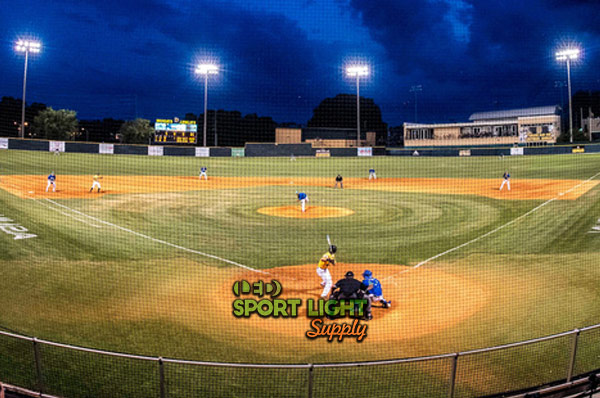
Lux and Footcandle (Brightness) Requirements
Before installing lighting at a baseball or softball field, it is crucial for the stadium owner to consult a lighting designer or engineer. The recommended light levels are determined by the level of play and must comply with regional or national standards.
For recreational or Little League baseball and softball fields, the minimum lighting criteria are as follows: the infield should have 30 footcandles (fc) and the outfield should have 20 fc. In metric terms, this translates to 540 lux in the infield and 320 lux in the outfield.
However, the lighting requirements may vary based on the level of competition. For example, televised games require higher lighting standards to ensure adequate recording conditions. High school competitions typically demand up to 50 fc in the infield and 20 fc in the outfield.
Light Uniformity
Ensuring the quality of lighting involves measuring light uniformity. Three essential factors are considered in this process:
Uniformity Ratio
The uniformity ratio measures the consistency of light levels across the field. For the infield, the ratio should be between 0.6 and 0.7, while for the outfield, it should range from 0.4 to 0.5. This ratio helps maintain a consistent level of illumination across different areas of the field.
Uniformity Gradient
The uniformity gradient refers to the smoothness of light distribution across the field. It is important to avoid abrupt changes in light intensity. For example, if one spot has 200 lux and a nearby spot has 500 lux, the gradient exceeds the acceptable limit. Maintaining a gradual transition in light levels helps ensure a more uniform playing experience.
Coefficient of Variation
The coefficient of variation is a mathematical ratio used to calculate the standard deviation of light levels across the field. It ensures that, on average, all areas of the playing field receive adequate illumination. This measure is crucial for maintaining consistent lighting conditions.
Color Temperature
While brightness is a key factor, the color temperature of the lights also plays an important role. LED lights offer various color temperatures measured in Kelvin (K).
| Light Type | Color Temperature Range | Description |
|---|---|---|
| Warm Light | 4,500 K to 5,500 K | Provides a daylight appearance. |
| Cool Light | 5,500 K to 6,500 K | Offers a bluish-white hue. |
Lights with a color temperature below 4,500 K tend to be too yellowish and are generally not used. Conversely, a color temperature above 6,000 K may appear too bluish. Choosing the appropriate color temperature ensures optimal visibility and a pleasant visual experience.
CRI and TLCI
Color Rendering Index (CRI) and Television Lighting Consistency Index (TLCI) are crucial for creating the right atmosphere, especially for televised events.
| Index | Description | Recommended Score |
|---|---|---|
| CRI (Color Rendering Index) | Measures how accurately the light renders colors compared to natural light. | 95 or higher |
| TLCI (Television Lighting Consistency Index) | Designed for broadcasting to ensure better color accuracy on screen. | Above 85 on a scale of 100 |
High-quality lighting with excellent CRI and TLCI values provides stable color temperatures and accurate color rendering, which is essential for both live and broadcast events.
Light Spill and Pollution
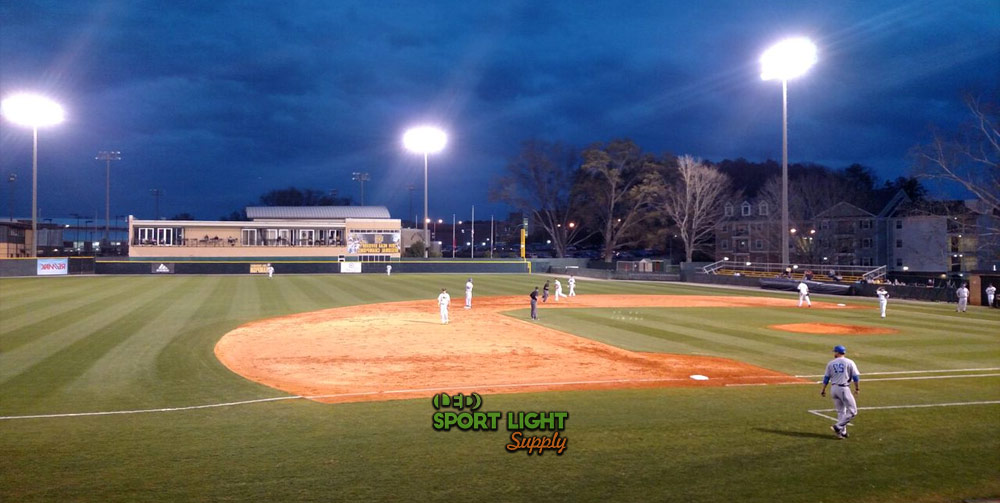
Light pollution is a significant concern, particularly for high school and college facilities located in residential areas. Proper design can mitigate light pollution, which can negatively impact nearby drivers and residents.
To reduce light spill, each fixture should be aimed at the field at recommended angles and equipped with shielding. Adhering to local planning committee ordinances and guidelines will help minimize light pollution and ensure that the lighting design is both effective and considerate of the surrounding environment.
How to Evaluate the Lighting Requirements in a High School Baseball Stadium
After purchasing and installing the lighting system, it is essential to assess whether it meets the necessary requirements. This evaluation should be conducted by the field owner or a representative from the high school or college. Here’s a step-by-step guide to ensuring that the lighting system complies with the standards:
Measure Lux Levels
Begin by measuring and recording the lux levels at various points across the baseball field using a lux meter. To achieve accurate results, follow a light level grid point layout specific to your athletic field. The grid should cover different areas of the field, and recording measurements at multiple points will yield more precise results.
Verify Compliance with Standards
To verify compliance with regional or national lighting standards, position the lux meter approximately 36 inches above the ground in the center of each grid square. This measurement height helps in obtaining an accurate average lux or footcandle value for each designated area.
Calculate the Uniformity Ratio
To assess lighting uniformity, calculate the uniformity ratio by comparing the highest and lowest readings recorded. This ratio should be determined separately for both the infield and outfield.
Uniformity Ratio – Divide the highest reading by the lowest reading to obtain this ratio. This calculation helps in evaluating the consistency of illumination across the field.
Assess Overall Compliance
Compare the recorded lux levels and uniformity ratios against the specified requirements. Ensure that the lighting system meets or exceeds the minimum criteria for brightness and uniformity as outlined in regional or national standards.
Baseball Field Lighting Buyer’s Guide
Luminous Efficacy
When purchasing or replacing flood lights, the lumen-to-watt ratio is a critical factor to consider. A ratio of 150 lumens per watt (lm/W) or higher is generally recommended. Lumens measure the total quantity of light emitted by a light source, and this information, along with the wattage, can typically be found on the product packaging in the specifications section.
Beam Angle
The beam angle of a flood light affects how widely the light is distributed. A larger beam angle is ideal for illuminating short-range areas and wider spaces, while a smaller beam angle is better suited for long-range illumination. Most LED flood lights come with a beam angle ranging from 70 to 120 degrees. If you require a narrower beam angle, consider using spotlights. Ensure that fixtures are installed with the correct vertical angle to meet standardized lighting requirements and use shielding to minimize light spill.
Lifespan
LED lights are known for their longevity compared to other lamp types. High-quality LED flood lights can last over 150,000 hours, making them a reliable choice for consistent light intensity. Additionally, LED lights are environmentally friendly, containing no toxic elements, unlike metal halide lights, which contain mercury, or halogen lamps, which emit ultraviolet radiation.
Color Temperature
The color temperature of stadium flood lights affects the quality of illumination. For natural lighting, bulbs with a color temperature of 5,500 Kelvin (K) are recommended. Temperatures above 7,000 K may appear too cold and bluish, which can feel unnatural and uncomfortable. Warmer hues are generally more pleasing to the eye and ensure a comfortable viewing experience when brightness levels are appropriately standardized.
Heat Dissipation System
A good heat dissipation system is essential for extending the lifespan of LED flood lights. Overheating can accelerate the wear of bulbs, so an effective heat sink is important. Although LED lights generate less heat than other types of lamps, they can still experience heat peaks, especially during warmer seasons. Ensure that the fixture includes a high-quality heat dissipation system or inquire about it before purchasing.
Light Shield
To prevent light pollution, opt for fixtures equipped with light shields. Shields help to reduce light spill and minimize the impact on surrounding areas. Barn doors or additional shielding accessories can be used to focus the light and optimize its use. Make sure to select the correct size and type of shield for your lights.
Customized Installation Bracket
The installation bracket, similar to an adapter, is used to mount lights onto the poles. Some manufacturers offer customizable brackets, while others do not. It is crucial to ensure that the bracket fits properly and can be customized if needed, to avoid complications when replacing flood lights.
Weight of Luminaires
Before making a purchase, consult the engineer’s specifications for the light poles. The poles must be able to support the weight of the flood lights, taking into account potential additional weight from snow and ice over time. The engineer should provide information on the maximum load each pole can handle. If this information is not readily available, seek advice from your lighting engineer or designer.
Why Fulfill the High School Softball Stadium Lighting Standard?
Enhancing Students’ Vision
Adequate lighting is crucial for softball players due to the sport’s fast pace, which can be even quicker than baseball. Players need to see clearly to react swiftly, whether they are base runners sprinting or pitchers focusing on their throws. Insufficient lighting can impair vision, increasing the risk of injuries and accidents. For slow-pitch softball, where precise timing and focus are essential for hitting the ball, proper lighting ensures that players can perform at their best without straining their eyes.
Creating a Welcoming Atmosphere
Effective lighting not only supports gameplay but also enhances the overall atmosphere of the stadium. Good lighting makes the venue more inviting and enjoyable for both players and spectators. It creates a sense of safety and well-being, making the experience more pleasant. Additionally, proper lighting helps capture the attention of fans and spectators, whether they are attending the game in person or watching from home. Ensuring that connections are buried and cables are secured reduces the risk of tripping, further enhancing the comfort and safety of the environment.
Ensuring Safety and Security
As games extend into the evening, well-lit entrances and pathways contribute significantly to safety and security. Proper lighting deters potential theft and reduces the risk of assaults. Installing lights around the stadium, including outdoor areas, enhances visibility and protection. Using timers or motion-sensor LED lights can further increase security by ensuring that areas are illuminated during crucial times and conserving energy when the stadium is not in use.
Conclusion
Meeting high school softball field lighting standards is essential for several reasons. It improves players’ vision, creates a welcoming atmosphere, and enhances safety and security. Lighting requirements may vary by state but generally adhere to national guidelines. Before installing an LED floodlight system, it’s important to develop a comprehensive lighting layout that meets the required lux levels and ensures uniformity. Following the recommended features for lighting will help achieve optimal results and provide a better experience for everyone involved.
